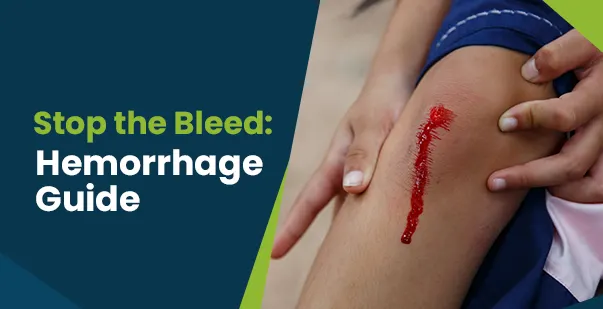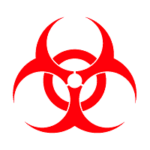A hemorrhage is a medical term for bleeding caused by damage to a blood vessel. In simple words, it happens when blood leaks out due to an injury or damage to tissues. Everyone has experienced some form of bleeding, either from a small cut, scratch, or pinprick. While these are mild examples of hemorrhage, some cases can be much more serious. The severity of a hemorrhage depends on three main factors: where the bleeding occurs, which type of blood vessel is damaged (arteries are usually more serious than veins), and how much blood is lost. So, scroll down to explore the types of hemorrhages, common symptoms, causes, treatments, and first aid steps to take in such emergencies.
What is a Hemorrhage?
A hemorrhage is the acute loss of blood caused by damage to a blood vessel. It can range from minor bleeding caused by a small cut on the skin to severe internal or external bleeding due to major injuries, like fractures or gunshot wounds. Regardless of size, a hemorrhage always involves a damaged blood vessel, whether it’s a capillary, vein, or artery.
Hemorrhages can occur anywhere in the body, from external wounds to internal bleeding in organs or tissues. Based on the site of the bleeding, hemorrhages can be classified as gastrointestinal (upper and lower) hemorrhage, intracranial hemorrhage, pulmonary hemorrhage, hemoptysis (coughing up blood from the lower respiratory tract), hematuria (blood in urine), and nasal (epistaxis) hemorrhage.
Minor bleeding often stops on its own, but severe hemorrhages, like those from major injuries or internal trauma, require urgent medical attention. Note that minor bleeding should still be treated as the open wound can get infected.
How Many Types of Hemorrhage Occurs?
Hemorrhages, or bleeding caused by damaged blood vessels, can be categorized in various ways. The two main types are external hemorrhages and internal hemorrhages, which differ based on the location of the bleeding relative to the body. Additionally, hemorrhages are further classified based on the type of blood vessel involved. Let’s explore these in detail.
Classification Based on the Location
A damaged blood vessel can either trap or pool blood within the body or allow it to flow out. Hemorrhages are typically categorized into two main types: external and internal.
External Hemorrhage
When the bleeding occurs through a wound or natural openings like the nose, mouth, or ears, it is known as an external hemorrhage. It is caused by a cut, laceration, or puncture wound. External bleeding is easier to detect and manage because it is visible. It can be stopped by applying pressure using a clean cloth.
Internal Hemorrhage
Internal bleeding occurs when blood is trapped or pools inside the body. It can happen in organs, tissues, or cavities such as the chest or abdomen. This type of hemorrhage is more difficult to detect and can quickly become fatal if not treated on time. Diagnostic procedures such as computed tomography (CT) scan, radionuclide scan (GI bleed scan), angiography, endoscopy, laparoscopy, magnetic resonance imaging (MRI), and ultrasonography are used to detect internal hemorrhage.
Classification Based on The Type of Blood Vessel
Additionally, based on what kind of blood vessel is damaged, there are three types of hemorrhages, which are discussed as follows:
Arterial Hemorrhage
Arterial hemorrhage is particularly severe and noticeable because arteries carry oxygen-rich blood at high pressure from the heart to the tissues. The blood is bright red due to the high oxygen content and spurts in rhythm with the heartbeat. The rapid loss of oxygenated blood causes vital organs, such as the brain and heart, to suffer from a lack of oxygen, which increases the risk of shock and organ failure. Thus, arterial hemorrhages can quickly lead to life-threatening conditions.
Venous Hemorrhage
Venous hemorrhage occurs as a result of damaged or broken veins. This type of hemorrhage, even though significant, is less severe than arterial hemorrhage. However, it requires immediate attention and treatment as significant loss of blood can be fatal. Hemorrhaging from damaged veins results in dark red blood flowing in a steady pattern from the affected vein.
Capillary Hemorrhage
Capillary hemorrhage occurs when the smallest blood vessels, the capillaries, are damaged. The bleeding is usually slow and appears as a trickle or oozing from the wound. Capillary hemorrhages are the least severe and often stop on their own, but they can still be painful and prone to infection if not cleaned properly.
Types of Hemorrhages Encountered in Medical Emergencies
Here are some specific types of hemorrhages that are frequently encountered and may require medical attention:
Intracranial hemorrhages refer to bleeding inside the skull. They occur due to head injuries, ruptured blood vessels, or conditions like high blood pressure. This type of hemorrhage is a medical emergency because it can compress the brain and cause severe complications. Based on the relation between the layer of the skull and brain with the bleed site, intracranial hemorrhages occur in four different ways:
- Epidural Hematoma: It occurs when the blood collects between the skull and the outer layer of the brain.
- Subdural Hematoma: It happens when blood pools between the brain and its outer membrane.
- Subarachnoid Hemorrhage: When bleeding occurs between the brain and a thin covering called the arachnoid.
- Intracerebral Hemorrhage: It occurs when the blood leaks directly into brain tissue.
- Hemothorax
This is a type of internal hemorrhage in which blood collects in the pleural cavity, the space between the lungs and chest wall. A hemorrhage in the pleural cavity compresses the lungs, resulting in chest pain and breathing difficulties.
- Postpartum Hemorrhage (PPH)
Postpartum hemorrhage is a serious hemorrhagic condition that happens as vaginal bleeding after childbirth. It is defined as losing more than 500–1000 ml of blood after delivery. PPH can occur immediately after birth or within 12 weeks of delivery. This condition is the leading cause of maternal death worldwide. Symptoms include heavy vaginal bleeding, low blood pressure, and rapid heartbeat.
- Subconjunctival Hemorrhage
Subconjunctival hemorrhage occurs when blood vessels in the eye are damaged. This causes blood to pool in the white part of the eye. This kind of bleeding is not very serious.
Ruptured aneurysms are hemorrhages resulting from the tearing of an abnormally bulged blood vessel wall. There are several types of ruptured aneurysms based on the site of occurrence, such as cerebral aneurysms, abdominal aortic aneurysms, and thoracic aneurysms. Thoracic and abdominal aneurysms can result in abdominal and gastrointestinal bleeding. Venous aneurysms are rare as compared to aortic aneurysm. However, both are life-threatening conditions and require immediate attention.
Hemorrhagic shock occurs when the body loses a large amount of blood, either externally or internally. This condition reduces the body’s ability to circulate oxygen and nutrients to vital organs. It is a life-threatening condition in which the patient enters a stage of shock due to the loss of a large volume of blood. Symptoms include pale skin, rapid breathing, confusion, and fainting.
- Ruptured Esophageal Varices
Esophageal varices are dilated and abnormally enlarged veins in the esophagus that obstruct portal circulation. However, when pressure in the esophagus elevates, it can cause the varices to rupture, resulting in a life-threatening hemorrhage in the GI tract.
Read More: Venous Bleeding vs. Artery Bleeding: Overview & Treatment
What Are The Main Causes of Hemorrhage?
A hemorrhage can happen for a wide variety of reasons. However, almost all hemorrhages happen as a result of either a traumatic injury or an underlying pathology.
Traumatic Injury
Traumatic injuries are of varying severity based on the impact of the injury. Commonly seen traumatic injuries that cause hemorrhage include abrasion, hematoma (or bruising), gunshot wounds, lacerations, crush injuries, and puncture wounds. Traumatic injuries tend to result in external hemorrhage if the trauma breaches the continuity of the skin and underlying tissues.
Another common cause of hemorrhage resulting from trauma is a fall that impacts the head, which can induce intracranial hemorrhage in individuals. Such traumatic injuries cause internal hemorrhages. Surgical complications can also cause traumatic injuries and internal hemorrhages.
Pathological Causes
Apart from traumas and injuries, certain pathologies and disease conditions can also cause hemorrhage. Most hemorrhages resulting from pathological causes result in internal bleeding. A few such conditions that cause hemorrhages are:
- Leukemia,
- Thrombocytopenia,
- Peptic ulcer,
- Esophageal varicose,
- Liver diseases,
- Vitamin K deficiency, and
- Colon diverticulosis.
In certain patients, drug or medication overdose by NSAIDs, blood thinners, aspirin, or radiation therapy can also result in hemorrhages. A few of the commonly used medications that can trigger hemorrhage include warfarin, ibuprofen, naproxen, clopidogrel, flurbiprofen, and escitalopram. Herbal supplements with ginseng, aloe vera, and ginkgo biloba are also known to increase the risk of bleeding when taken with warfarin.
Risk Factors
Certain factors can cause an increased risk of blood loss. They include:
- Family history of bleeding disorders
- Old age
- Alcohol
- Smoking
- Health conditions like diabetes, hypertension, vitamin K deficiency, and bleeding disorders.
What Are The Symptoms of a Hemorrhage?
The symptoms of a hemorrhage differ depending upon the volume of blood lost, the site of the hemorrhage, and its severity. Based on the percentage of blood loss, hemorrhage is classified into four categories:
- Class I Hemorrhage: Up to 15% of total blood volume is lost.
- Class II Hemorrhage: 15–30% of total blood volume is lost.
- Class III Hemorrhage: 30–40% of total blood volume is lost.
- Class IV Hemorrhage: Greater than 40% of total blood volume is lost.
Symptoms of Early Stage Hemorrhage
Class I hemorrhage is not considered severe since it does not impact bodily functions or display any symptoms. However, during a class II hemorrhage, the following symptoms develop:
- Dizziness or lightheadedness from reduced blood pressure,
- Increased heart rate,
- Weakness,
- Fatigue,
- Nausea,
- Vomiting, and
- Shortness of breath with increased breathing rate.
Symptoms of Advanced Stage of Hemorrhage
Class III and Class IV hemorrhages result in complications like:
- Altered mental state or confusion
- Seizures
- Loss of consciousness
- Coma
- Hypovolemic shock.
Symptoms of an External Hemorrhage
An external hemorrhage is visible because blood flows out of the body through a wound or an opening, like the nose or ears. Symptoms of external bleeding include:
Symptoms of an Internal Hemorrhage
Internal bleeding is difficult to spot as compared to external bleeding. It requires radiological examination or other investigatory methods to diagnose. However, based on the site of hemorrhage, symptoms of internal hemorrhage vary, which are discussed as follows:
- If the bleeding occurs in the head, symptoms include confusion, sudden and severe headaches, vision changes, or weakness in one part of the body. These can indicate a brain hemorrhage.
- In the case of Class II hemorrhages, patients may experience cold hands and feet due to circulatory failure caused by blood volume lost.
- If the bleeding occurs in the chest, as in the case of a hemothorax, patients will experience severe chest pain, dyspnea, and coughing of blood in the sputum.
- Bloody vomit, swelling feeling of fullness, heaviness of stomach, and abdominal bruising are also seen in internal hemorrhages concerning the abdomen.
- Vomit or stool with fresh blood is indicative of bleeding related to the esophagus or intestines, respectively.
- Internal bleeding in bones and muscles can happen due to underlying pathology. The commonly elicited symptoms are bruising, swelling, and pain. It is also considered a medical emergency because increased pressure caused by pooled blood with the closed space can compress nerves and blood vessels, thereby causing permanent loss of function.
- In certain cases, silent internal hemorrhages can happen wherein no symptoms develop until the situation has turned critical. This happens in cases of aneurysms and cancers of the GI tract. In cerebral aneurysms, some patients may not develop symptoms of headache or altered mental state. Similarly, in duodenal cancer, internal hemorrhage happens with no evidence of blood loss or pain. In some patients, this kind of hemorrhage and its underlying conditions only come into notice after RBC and Hb count are found to have dropped in blood investigations.
An internal hemorrhage can also, at times, cause bleeding through openings like the mouth, nose, ears, anus, vagina, and urethra. Some types of internal bleeding can also cause changes in skin color.
Symptoms of a Hypovolemic Shock or Hemorrhagic Shock
Loss of blood above 20% of the total blood volume can result in hypovolemic shock. It can result from both internal and external hemorrhage. The most commonly elicited symptoms of this condition include:
- Dizziness,
- Nausea,
- Vomiting blood,
- Confusion and changes in mental state,
- Seizures,
- Swelling,
- Lethargy,
- Pale, bluish, or greyish sweaty skin,
- Shortness of breath,
- Extreme thirst,
- Sudden severe headache.
How Doctors Treat Hemorrhage?
Hemorrhages are treated based on the cause, site, external or internal location, and severity of bleeding. A patient’s overall health and medical history also play a role in deciding the course of action. Here’s how hemorrhages are managed:
External Hemorrhages
External bleeding with very little blood loss can be managed with first aid methods. The primary goal of treatment here is to stop the hemorrhaging and prevent infection. For more severe external bleeding, stitches or staples may be needed to close the wound. If the bleeding doesn’t stop or is excessive, the person should be taken to a hospital immediately.
Internal Hemorrhages
Internal bleeding cannot be controlled by first aid alone. Once shifted to a hospital, the patient would be provided with adequate oxygen while controlling bleeding and limiting tissue death. Once the cause has been found, the patient would be suggested for surgery, wound care, IV transfusion, Vit K injection, and blood transfusion based on their condition.
First Aid Care in Hemorrhages
Giving first aid to a minor external hemorrhage is easy. However, one must ensure proper hygiene and care while carrying it out. Following are the key steps you can follow to manage bleeding with first aid:
For Minor External Bleeding:
- Wash your hands to maintain hygiene.
- Clean the affected site with mild soap under flowing water.
- Apply steady pressure with a clean cloth to stop the bleeding.
- Bandage the wound securely.
For Severe External Bleeding
- Call 911 immediately.
- Cover the wound with a clean cloth.
- To control severe bleeding, apply a tourniquet about 2 inches above the wound site. Use a clean cloth to create a simple knot, then insert a stick or similar object through the knot. Twist the stick in one direction to tighten the cloth until the bleeding stops.
In case of severe external bleeding, controlling the bleeding using a tourniquet or by pressure application helps to reduce the amount of blood lost from the hemorrhage. This prevents the patient from entering into a hemorrhagic shock. If the patient has already lost a large quantity of blood, controlling shock and keeping the patient warm until medical help arrives increases their chances of survival.
For Nosebleeds or Epistaxis
- Ask the person to sit up and pinch their nose with their finger, with their head slightly tilted forward. This prevents aspiration of blood.
- Request the person to breathe through their mouth.
- Apply an ice pack on the forehead, neck, and near the nose.
- Ask them to spit out the blood.
- If the bleeding doesn’t stop, seek medical help immediately.
Read More: How to Attend to a Stab Wound with First Aid: A Comprehensive Guide
What Are The Complications of Hemorrhage?
The most serious concern with hemorrhage is the reduced blood flow to the vital organs. The lack of oxygenated blood can lead to tissue and cell death, which may cause organ failure, seizures, coma, and, eventually, death. If the hemorrhage becomes very severe, the patient may develop a condition called the “lethal triad of hemorrhage,” which signals a poor outcome. This lethal triad is a complication comprising acidosis, coagulopathy, and hypothermia. Each component of this triad cyclically causes the other two factors to worsen.
Acidosis
When a person loses a lot of blood, their body doesn’t get enough oxygen. Without oxygen, the cells produce too much acid, which builds up in the blood. This acidic environment makes it harder for the body to function properly and can damage the organs.
Coagulopathy
This occurs when blood loses its ability to clot properly. Clotting is essential to stop bleeding, but in severe hemorrhage, the body may run out of the components required for clotting or may not work efficiently. This can lead to more blood loss.
Such cases of coagulopathy are managed by administering antifibrinolytics and clotting factor replacement therapy. Antifibrinolytics inhibit fibrinolysis and promote clot formation along with 12 different clotting factors and vitamin K.
Once the coagulopathy is managed, a blood transfusion is carried out to replace the lost blood. Also, based on the condition of the patient, replacement of deficient components of lost blood such as fresh frozen plasma, platelet transfusion, or specific factor replacement is performed.
Hypothermia
Severe blood loss can lower the body’s temperature because the blood helps maintain warmth. When the body gets too cold, it affects how well the blood clots and can further worsen acidosis and coagulopathy.
In trauma cases, hemorrhage is one of the leading causes of death. Some patients may also experience rebleeding or infections, which can make their condition worse. However, quick first aid provided by a trained individual can significantly improve the chances of recovery for someone experiencing severe bleeding.
Manage Hemorrhage Confidently With The Right Approach!
A hemorrhage is any bleeding resulting from a damaged blood vessel. Its impact depends on the patient’s health, the severity of the bleeding, and its cause. External hemorrhages of little blood loss can almost completely be managed with first aid. Any patient who is suspected to have an internal hemorrhage or an external hemorrhage with significant blood loss must be shifted immediately to a hospital setup. Even if there is significant blood loss in external hemorrhage, first aid methods can help to reduce the intensity or volume of blood lost until paramedics arrive and shift the patient to a hospital.
FAQs
- What does it mean when someone is hemorrhaging?
When a person is said to be hemorrhaging, it means that the patient is undergoing loss of blood in large volume, either through external or internal bleeding. Hemorrhage can be serious, and without treatment, it can lead to major health issues, like organ failure or even death.
- Is hemorrhaging the same as bleeding?
Yes. Hemorrhaging is the same as bleeding. A patient said to be having an internal or external hemorrhage means that an artery vein or capillary has been damaged and that the patient is having a significant amount of blood loss from that blood vessel. It often requires immediate medical help to stop the bleeding and prevent further damage.
- What would cause a hemorrhage?
A hemorrhage can result from either a trauma or injury or due to underlying pathology. Abrasions, lacerations, and gunshot wounds all cause trauma to the body and thereby result in hemorrhage. Certain disease conditions or pathologies like hemophilia, thrombocytopenia, esophageal varices, and even some types of cancers can cause internal bleeding or hemorrhages.
- What happens to the body during hemorrhage?
A hemorrhage occurs when a blood vessel ruptures. If the hemorrhage is internal, it can cause blood to pool inside the body. If it is external, it can cause blood to flow out of the body. In both cases, the body loses a large amount of blood from its circulatory system, reducing blood flow to the tissues and organs. If unattended and the blood loss progresses, the patient might experience hypovolemic shock.






